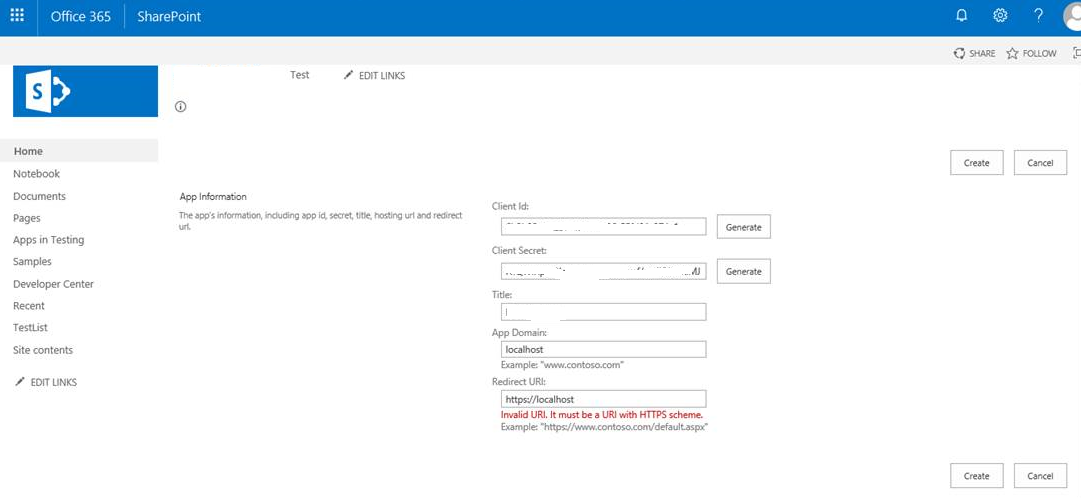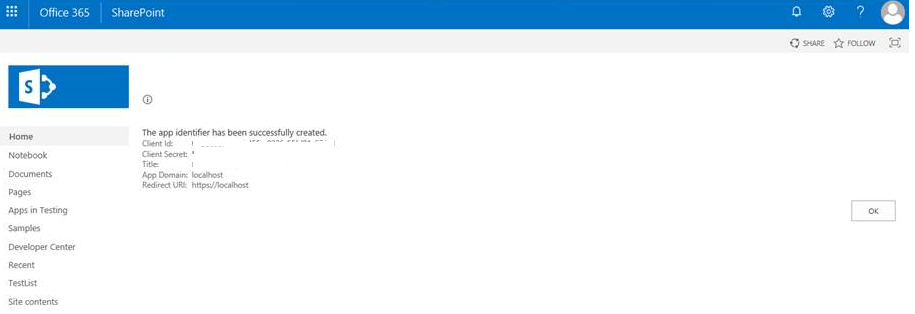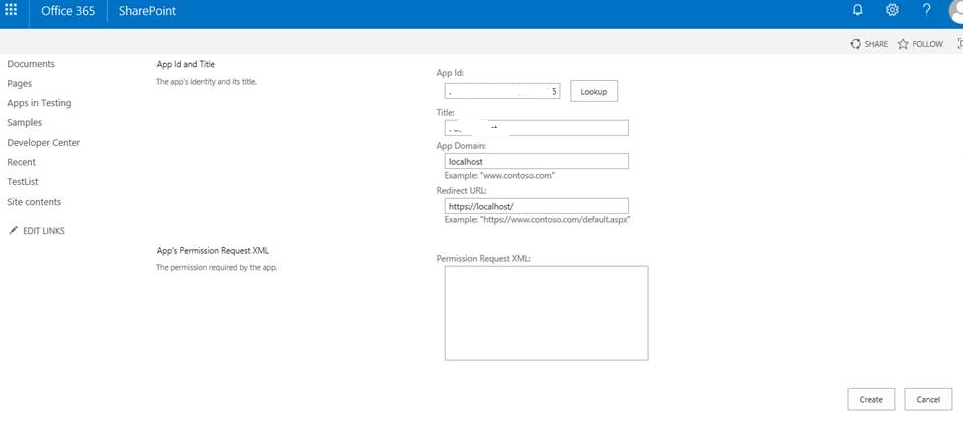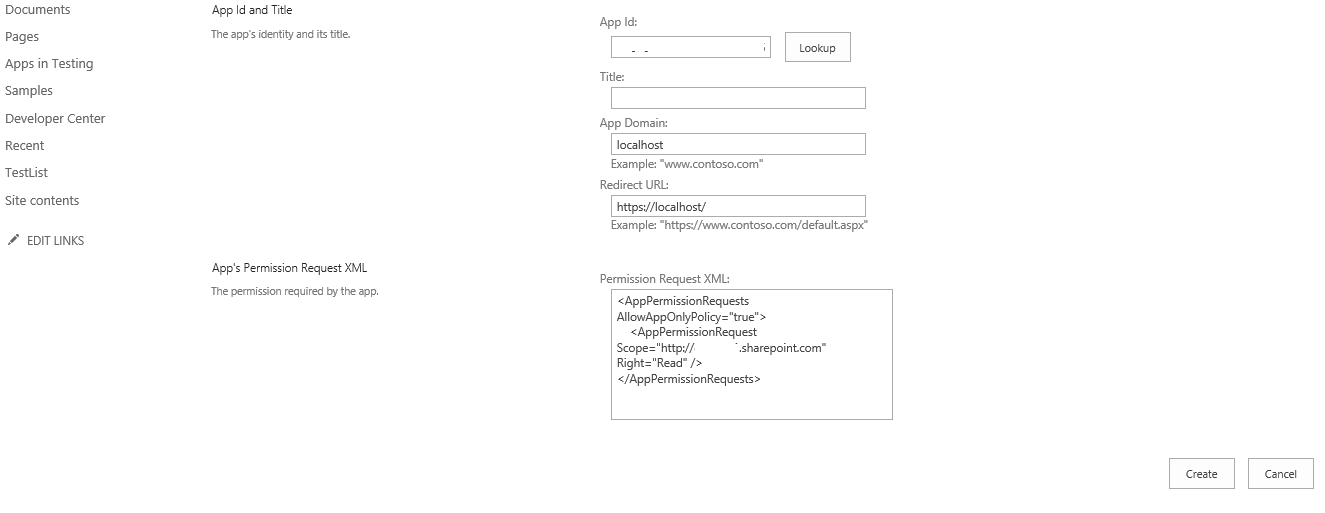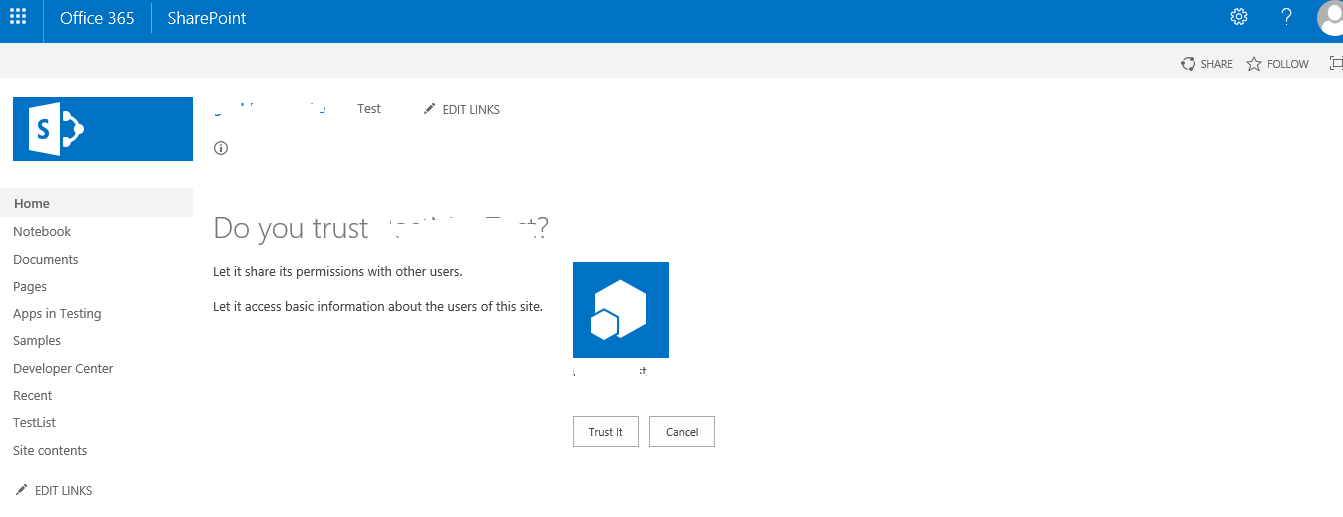SharePoint: Read online list data from c# console Application using Access Token
Step 1: Register an App in SharePoint online
Go to the SharePoint online URL : https://.sharepoint.com/_layouts/15/appregnew.aspx
Register an App
Provide the information and click on the create button
Now go to the https://.sharepoint.com/_layouts/15/appinv.aspx and provide the permission
Enter the client ID (from the previous screen) click on the lookup button
Enter the below XML in the permission Request XML Text box
Format :
<AppPermissionRequests AllowAppOnlyPolicy="true">
<AppPermissionRequest Scope="http://sharepoint/content/sitecollection/web" Right="Read" />
</AppPermissionRequests>
Click on the Create button and trust the app
Step 2: Write a console Application using c#.net to get the access token and call REST API
using System;
using System.Collections.Generic;
using System.Linq;
using System.Text;
using System.Net;
using System.Web;
using System.IO;
using System.Threading;
using System.Threading.Tasks;
namespace SPTokenService
{
public class RequestState
{
// This class stores the request state of the request.
public WebRequest request;
public RequestState()
{
request = null;
}
}
public class ResponseState
{
// This class stores the response state of the request.
public WebResponse response;
public ResponseState()
{
response = null;
}
}
class RetrieveSPListData
{
static void Main(string[] args)
{
try
{
Console.WriteLine(" ################################### ");
Console.WriteLine(" Read SP online Data ");
Console.WriteLine(" ################################### ");
// To create a new app go to url : https://<;sitename>.sharepoint.com/_layouts/15/appregnew.aspx
// To set the permission https://<;sitename>.sharepoint.com/_layouts/15/appinv.aspx
// To list : http://<;SharePointWebsite> /_layouts/15/AppPrincipals.aspx
// XML : <AppPermissionRequests AllowAppOnlyPolicy="true">
// <AppPermissionRequest Scope="http://sharepoint/content/sitecollection/web" Right="Read" />
// </AppPermissionRequests>
#region URL
WebRequest myWebRequest;
string stGetTenantDetailsUrl = "https://gandxb1.sharepoint.com/_vti_bin/client.svc/";
string stGetAccessTokenUrl = "https://accounts.accesscontrol.windows.net/{0}/tokens/OAuth/2 ";
string tenantID = string.Empty;
string resourceID = string.Empty;
string accessToken = string.Empty;
string stClientID = "Client_ID"; // pass the client id which is created in Step 1, https://<;sitename>.sharepoint.com/_layouts/15/appregnew.aspx
string stClientSecret = "Client_SecretCode"; // pass the client secret code which is created in step 1
string stSiteDomain = "gandxb1.sharepoint.com";
string stSiteDetailsUrl = "https://gandxb1.sharepoint.com/_api/web?$select=Title";
#endregion
#region Get Tenant ID by HttpRequest
//read the url https://<;sitename>/sharepoint.com/_vti_bin/client.svc
// get the http header of WWW-Authenticate
// and get the Realm value
// and the resource value (which will come in Client id attribute
myWebRequest = WebRequest.Create(stGetTenantDetailsUrl);
myWebRequest.Method = "GET";
myWebRequest.Headers.Add("Authorization", "Bearer");
WebResponse myWebResponse = null; ;
try
{
myWebResponse = myWebRequest.GetResponse();
}
catch (System.Net.WebException ex)
{
//get the Web exception and read the headers
#region Parse the WebException and read the WWW-Authenticate
string[] headerAuthenticateValue = ex.Response.Headers.GetValues("WWW-Authenticate");
if (headerAuthenticateValue != null)
{
//get the array separated by comma
//Console.WriteLine(" Value => " + headerAuthenticateValue.Length);
foreach (string stHeader in headerAuthenticateValue)
{
string[] stArrHeaders = stHeader.Split(',');
//loop all the key value pair of WWW-Authenticate
foreach (string stValues in stArrHeaders)
{
// Console.WriteLine(" Value =>" + stValues);
if (stValues.StartsWith("Bearer realm="))
{
tenantID = stValues.Substring(14);
tenantID = tenantID.Substring(0, tenantID.Length - 1);
}
if (stValues.StartsWith("client_id="))
{
//this value is consider as resourceid which is required for getting the access token
resourceID = stValues.Substring(11);
resourceID = resourceID.Substring(0, resourceID.Length - 1);
}
}
}
}
#endregion
}
Console.WriteLine(" Tenant ID " + tenantID);
Console.WriteLine(" Resource ID " + resourceID);
#endregion
#region Get Access Token using TenantID and App secret ID & Password
// URL Format
//https://accounts.accesscontrol.windows.net/tenant_ID/tokens/OAuth/2
stGetAccessTokenUrl = string.Format(stGetAccessTokenUrl, tenantID);
myWebRequest = WebRequest.Create(stGetAccessTokenUrl);
myWebRequest.ContentType = "application/x-www-form-urlencoded";
myWebRequest.Method = "POST";
// Add the below body attributes to the request
/*
* grant_type client_credentials client_credentials
client_id ClientID@TenantID
client_secret ClientSecret
resource resource/SiteDomain@TenantID resourceid/abc.sharepoint.com@tenantID
*/
var postData = "grant_type=client_credentials";
postData += "&client_id=" + stClientID +"@" +tenantID;
postData += "&client_secret=" + stClientSecret;
postData += "&resource=" + resourceID + "/" + stSiteDomain + "@" + tenantID;
var data = Encoding.ASCII.GetBytes(postData);
using (var stream = myWebRequest.GetRequestStream())
{
stream.Write(data, 0, data.Length);
}
var response = (HttpWebResponse)myWebRequest.GetResponse();
var responseString = new StreamReader(response.GetResponseStream()).ReadToEnd();
string[] stArrResponse = responseString.Split(',');
//get the access token and expiry time ,etc
foreach(var stValues in stArrResponse)
{
if(stValues.StartsWith("\"access_token\":"))
{
//Console.WriteLine(" Result => " + stValues);
accessToken = stValues.Substring(16);
//Console.WriteLine(" Result => " + accessToken);
accessToken = accessToken.Substring(0,accessToken.Length-2);
// Console.WriteLine(" Result => " + accessToken);
}
}
#endregion
#region Call REST Service
//https://<;sitename>.sharepoint.com/_api/web?$select=Title
myWebRequest = null;
myWebRequest = WebRequest.Create(stSiteDetailsUrl);
// Add the below headers attributes to the request
/*
* Accept application/json;odata=verbose application/json;odata=verbose
Authorization <token_type> <access_token> Bearer eyJ0eX….JQWQ
*/
// myWebRequest.Headers.Add("Accept", "application/json;odata=verbose");
myWebRequest.ContentType = "application/json;odata=verbose";
myWebRequest.Headers.Add("Authorization", "Bearer " + accessToken);
myWebRequest.ContentLength = 0;
myWebRequest.Method = "POST";
//call Asyncronously
//RequestState objRequestState = new RequestState();
//objRequestState.request = myWebRequest;
// myWebRequest.BeginGetResponse(GetResponseCallBack, objRequestState);
var responseREST = (HttpWebResponse)myWebRequest.GetResponse();
ResponseState objResponseState = new ResponseState();
objResponseState.response = responseREST;
myWebRequest.BeginGetResponse(GetResponseCallBack, objResponseState);
//var responseRestString = new StreamReader(response.GetResponseStream()).ReadToEnd();
// Console.WriteLine(" Site Details " + responseRestString);
#endregion
Console.ReadLine();
}
catch (Exception ex)
{
Console.WriteLine(" Error occured " + ex.Message);
Console.ReadLine();
}
}
static void GetResponseCallBack(IAsyncResult asynchronousResult)
{
try
{
//RequestState myRequestState = (RequestState)asynchronousResult.AsyncState;
//WebRequest myWebRequest = myRequestState.request;
ResponseState myResponseState =(ResponseState) asynchronousResult.AsyncState;
Console.WriteLine(" Site Info " + new StreamReader(myResponseState.response.GetResponseStream()).ReadToEnd());
}
catch(Exception ex)
{
}
}
}
}
